Review for Shangri-La: Part 1
Introduction
There’s just Blassreiter left after this, out of those first few shows from Gonzo that were streamed on Crunchyroll and opened up anime fandom to a whole new, legal way of consuming anime. Of those titles which got Western home video releases, MVM has released all but Blassreiter, with Linebarrels of Iron most recently joining The Tower of Druaga. But it is Shangri-La that I have most anticipated, and other than Saki which is yet to be licensed by anyone, Shangri-La has taken the longest to get an English language release. For a couple of years, it was only available in European territories, and it looked like no one in the US wanted to touch it, where all English localised anime originates these days. It took 3½ years after its broadcast before Funimation finally released it on DVD with an English dub, in an industry where most anime makes it to Western shores within 18 months. And it’s taken just over a year beyond that to make the trip via Australia to UK shores. Although this time it seems the detour wasn’t really necessary. But the wait has definitely been worth it, as of those initial Crunchyroll streams, Shangri-La was the most interesting, the better budgeted, the smarter and the more thought-provoking of anime. It’s also got an impressive visual aesthetic, with character designs by none other than Range Murata, the artist behind Last Exile’s character designs.
The future has arrived, and with it all that the doomsayers promised, climate change, rising seas, and the end of civilisation as we know it. Of course the end of the old civilisation means the start of a new one, and the world of tomorrow is governed by a new set of rules, a carbon based economy. Net producers of carbon dioxide pay hefty fines and taxes, nations that are carbon dioxide sinks get the tax breaks. For future Japan, that has been realised by turning what was Tokyo into one giant genetically engineered carbon-sink jungle, rapidly growing, and inimical to human life. What people remain in the city do so in small walled enclaves such as the Duomo settlement. But relief has been promised in the Arcology of Atlas, an immense construction that is a veritable city in the sky, that when completed will provide comfortable living for all of Tokyo’s residents, if it’s ever completed that is.
Kuniko Hojo is a young woman released back into this world after a couple of years of juvenile detention, and it soon becomes clear that she is a woman of destiny. She returns to Duomo where she is expected to be the next leader of the Metal Age terrorist group, people who resent the Carbon Economy and its restrictive taxes, and want to put the people first. But when she sees how the people of Duomo are treated by the government, and how they are denied residency in Atlas, her aims become much bolder, to change the very shape of the world. That she’s a formidable personality, and a mean aim with a boomerang becomes immediately clear to Lieutenant Kunihito Kusanagi, part of the army group sent into Duomo to clamp down on its profligate waste of energy. It’s a meeting that will change both their lives. In the bowels of Atlas lives a young albino girl named Mikuni, waited on hand and foot like a princess by her retinue, and possessing a strange and lethal psychic ability. These three people are linked by destiny, and by the ancient daggers that each of them bears.
Meanwhile, a shut-in girl named Karin plays the carbon exchanges like a maestro on her get rich quick schemes, aided by her considerable programming skills, and an AI named Medusa, to the point where she can buy and sell whole countries at the push of a button. And at the top of the Atlas tower, Ryoko Naruse looks down on the world with arrogant disdain, considering all these people as pawns to use to further her own power. Only the time has come for the pawns to fight back.
The first twelve episodes of Shangri-La are presented across 2 discs by MVM.
Disc 1
1. The Girl’s Return
2. The Poison Swamp of Ikebukuro
3. The Creation
4. Uber-Akihabara
5. Wild Dance of Madness
6. Fictitious Battle Lines
Disc 2
7. Sad Thoughts of Love and Hate
8. Lipstick Cruelty
9. Divine Prophecy of the Sun and the Moon
10. Blade of the Sacred Sound
11. Butterfly Dream
12. All is Constant Flux
Picture
Shangri-La gets a 1.78:1 anamorphic transfer in the NTSC format. I guess that it came via Australia as it’s been shorn of the Funimation logo and Funimation trailers, but really it is just what you would see if you bought the Region 1 discs anyway. The image is clear and sharp throughout, with strong consistent colours, and smooth and detailed animation. Even better, the discs are progressively encoded, so you will get 24 fps playback on compatible equipment, making for even smoother animation.
Shangri-La already excels in character design, given the input from Range Murata, but it also delivers a very engaging future world as well, with a post collapse society modelled outside of Atlas, while the rich and powerful live technologically enhanced lives inside the metropolis. Tokyo is turned into ruins encrusted with rainforest, with the odd enclave of humanity in isolated communities linked by canals and waterways. While Atlas is the future metropolis, places like Duomo are built anew on the ruins of the old, and then places like Akihabara somehow manage to stay recognisable beneath the greenery and hold onto their character. Shangri-La is a visually arresting show, and it’s done full justice with the character design and the quality of the animation, especially the action sequences. Aesthetically this is among the pinnacle of Gonzo’s output.
Sound
You have the choice between Funimation’s DD 5.1 Surround English dub, or the original Japanese DD 2.0 Stereo, with optional translated subtitles and a signs only track. I went with the Japanese audio and it was an agreeable enough experience, the cast suited to their characters, and the action sequences coming across well. Shangri-La is also blessed with some excellent music, both in terms of the incidental score, and the three theme songs, including a belter of an opening theme from May’n. I gave the English dub a try, and while it is enthusiastically performed, I didn’t feel all that comfortable with the script adaptation, awkwardly formal at times, clumsily colloquial at others.
However, I have to raise an eyebrow at the subtitles. Back when Manga Video were offending the masses, they would deliberately create profane dubs to raise the BBFC rating of their product, and court controversy. Funimation’s dub for Shangri-La isn’t the problem, the English subtitles are, which contain a degree of profanity beyond that which you would see in a show of this genre and early-teen target audience. The odd thing is that the profanity isn’t present in the dub, and Japanese by its very nature is not a language that is profane in the same way as English. The four-letter-word usage here looks very out of place and uncharacteristic, and puts me in mind of some of the lesser fansubs. I also don’t recall the Crunchyroll subtitles being like this, which makes me wonder just what Funimation were thinking when they subtitled this show. Incidentally, there is one incomprehensible subtitle caption 58:47 into disc 2.
Extras
The discs present their content with static menus, and jacket pictures when at rest in compatible players.
Disc 1 offers an audio commentary on episode 1, with ADR director Tyler Walker joining voice actors Kent Williams (Momoko), Lindsay Seidel (Kuniko), and Austin Tindle (Kunihito), for an interesting chat about dubbing the show. It suffers a bit from low volume muttering that’s hard to pick up, but generally it doesn’t descend too much into the usual Funimation back-slap and giggle, and actually has something to say about the series.
Disc 2’s audio commentary accompanies episode 10, and has Anastasia Munoz (Sayoko), Apphia Yu (Mikuni), and Randy Pearlman (Miiko) join Tyler Walker for a chat, and this time it is a little more character and plot focused. In the US, Shangri-La’s two parts were released simultaneously, and the commentators on this track assume that you have seen the whole series. Expect spoilers.
Disc 2 also has the textless credits comprising the opening and two closing sequences, trailers for Kiddy Grade and Red Garden, and finally a promotional video for “Magical Gina the Akiba Fairy” which lasts 2½ minutes, and promotes the fictional anime that can be seen playing in the background of scenes set in future Akihabara.
Conclusion
What with Crunchyroll viewings, this is my third time watching Shangri-La, and this first half of the show still holds up surprisingly well. The show came out in 2008 at studio Gonzo’s peak, when funds were profligate, and creators’ visions weren’t limited by the demands of the core otaku fanbase. Shangri-La is another futuristic sci-fi mystery action comedy drama melange of the same sort as the majority of Gonzo’s output since Kiddy Grade, but Shangri-La is also the most ambitious and visionary of the lot. It’s also smart, well-written and the most compelling and rounded future world that Gonzo has created for one of its shows. I’ve often thought that for Shangri-La, Gonzo took all that worked from their magnificent failure, Origin: Spirits of the Past, and invested it with a working narrative and interesting characters. That still feels true now.
I’ve also suspected that the reason Shangri-La took so long to license in the West is that it’s a show about climate change, and in 2008, at the end of the Dubya presidency, where Republicans had been busy debunking climate change science as hard as they could, selling such a show would have been a lot harder. Shangri-La had actually been out in Italy for two years before it got a US license. But it’s here now, and we can see its dystopian vision of a world reshaped by rising seas and the increased greenhouse effect. It’s easy to show a few flooded cities and a decimated civilisation, but Shangri-La tries to posit a future where mankind belatedly tries to fix the mess that it created. So it is that we have a carbon economy, where nations that reduce emissions, or indeed actively absorb greenhouse gases, get more favourable treatment than those who still pollute, and we get investors getting rich on trading carbon credits.
Japan has become a favoured economy by supplanting its cities with a genetically engineered jungle designed to soak up greenhouse gases. The downside to this is that this manmade jungle is actually inimical to human life, the noxious gases it exudes rapidly prove fatal, and it leaves people having to survive in isolated and walled off enclaves. The solution to this is the manmade city Atlas; a giant sealed construction designed to house the whole of the population, but while it’s under construction is only home to the fortunate and the elite. And as this series starts, it’s this elite which is the problem, seeking to increase personal power at the expense of the people, delaying the construction of utopia, and leaving the poor to languish outside, fighting to survive the ever-encroaching jungle.
Shangri-La is about the future of this world and the characters key to obtaining it. Ryoko Naruse is the power in Atlas, and she wants to shape the future in her image, and as this half of the show slowly reveals its secrets, it becomes apparent that she is subverting a plan long in the making. At its heart is the future heir to Atlas, and for some reason that heir will be one of three young people, the so-called Digmas, the erstwhile leader of the Metal Age terrorists, Kuniko Hojo, a Lieutenant in the armed forces, Kunihito Kusanagi, and the albino heliophobe princess Mikuni.
In this half of the series, it really plays its cards close to its chest when it comes to the story, and the character arcs, and while they do bounce off each other, intertwine and interact, they still pretty much remain apart. Ryoko is up in her ivory tower machinating and dominating. Mikuni’s the odd telekinetic girl who reflexively kills liars, but is doted on by her guardian Sayoko. Kunihito has his hands full trying to obey orders and every time he runs into Kuniko he gets his outlook on the world rebooted, while Kuniko is the show’s protagonist, ostensibly happy-go-lucky, but affronted by the injustices that she encounters, and determined to make right a world that she can see is going wrong.
One thing of interest is just how matriarchal this story is. All of the women hold the power, and the men are more secondary characters. Kuniko is the protagonist of the show, a capable fighter and a mean aim with a boomerang. Her grandmother Nagiko founded Metal Age and still provides sage advice. Karin is the shut-in girl with the ace computer powers, who with the aid of her AI Medusa goes about playing the carbon economy to fill her coffers and make her ever absent parents proud, while Sayoko will do whatever it takes to ensure that it is Mikuni who inherits the position as Atlas’ next leader. Of course the villainous Ryoko is apt to flaunt her femininity as she plots her next moves in amassing power, and it’s probably the only place that you’ll see fan service in the show.
Against this backdrop of female empowerment, the men are somewhat ineffectual, Ryoko’s coterie of servants really just there to be dominated by her, the powerhouse behind Metal Age, Takehito apt to fly off the handle and act without forethought, and Kunehito always playing catch-up to Kuniko, or out of his depth when it comes to doing his duty. The most interesting characterisations are surprisingly Momoko and Miiko, who were Kuniko’s caregivers when she was growing up. Momoko and Miiko are transsexuals, which in the average anime usually mean comic relief. There is an element of that here still, but they are rounded, engaging and nuanced characters beyond what you would normally see in anime. Momoko is a capable fighter, and you can see where Kuniko got her street-smarts and fighting skills from, and it also becomes clear that Momoko is the rock that Kuniko relies on. Miiko on the other hand isn’t a fighter, and early on she wins the Atlas lottery and gets to relocate. But rather than the perfect life that she was expecting, her old life is destroyed, and she winds up in Mikuni’s court, where few expect her to survive for long. The surprise isn’t that she survives, it’s that she becomes Mikuni’s primary caregiver, the mother that she never had. While Sayoko is always Mikuni’s advocate, she’s kept herself at an emotional remove from her charge, and Miiko fills a hole in Mikuni’s life that she didn’t realise she had. In a warped and dangerous world, it’s a heart-warming and genuinely caring relationship that emerges.
If Shangri-La does put a foot wrong at this point, it’s with the character of Ryoko, a moustache twirler of a villain if ever there was one, although in her case, she’d twirl the moustache of one of her servants, twist it, rip it off his face, and then rub salt in the wound. She’s evil for the sake of being evil, sadistic because it suits her fancy, and everything she does, she does for the sake of making the viewer despise her more. In fact the only one who adores her is her young masochist of a servant Shion, who esteems her abuse even more than he does his brother’s protectiveness. It’s the one sour note in the show, a single note character where a little balance and depth would have been interesting.
In many ways, Shangri-La is much like any other Gonzo sci-fi show. Action, comedy and mystery all thrown into a futuristic world to keep you entertained and guessing till the final episode, with interesting characters and epic action sequences. You could compare it to any Gonzo show of the mid-2000s, from Kiddy Grade, Last Exile, Speed Grapher, Trinity Blood or Burst Angel. The thing about Shangri-La is that it integrates its narrative and its ideas a lot more effectively than any other Gonzo show save perhaps Speed Grapher. It’s got some great sci-fi chops to it, a very interesting post climate collapse dystopia, an intriguing take on the future economy, and it’s also got a wee bit of mysticism thrown in as well for good measure. The first half of Shangri-La is a fast-paced, exciting romp of an adventure series, and is one of the best shows of its genre that Gonzo produced. This collection leaves it at quite a cliff-hanger, with Kuniko at the end of her tether, and poised to take the battle to Atlas itself. Fortunately we won’t have to wait as long for the second half as we did for the first. It’s out next month.


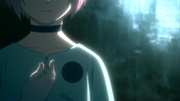

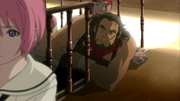

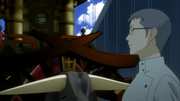






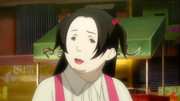





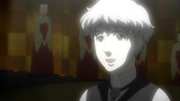
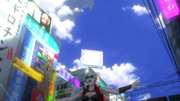

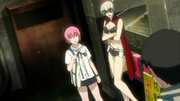

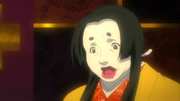


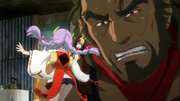











































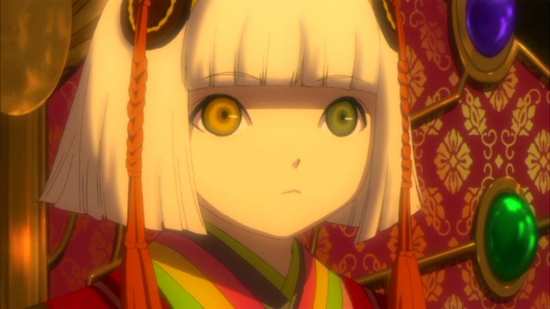


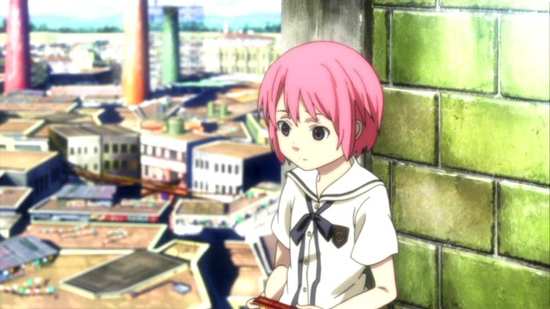







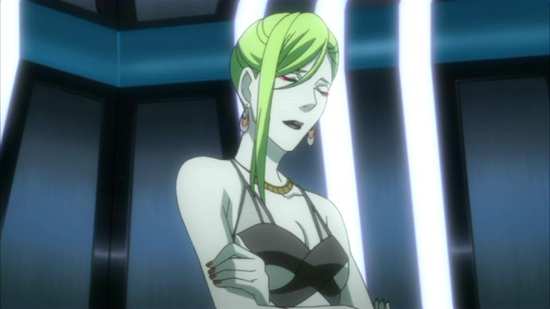
Your Opinions and Comments
Be the first to post a comment!